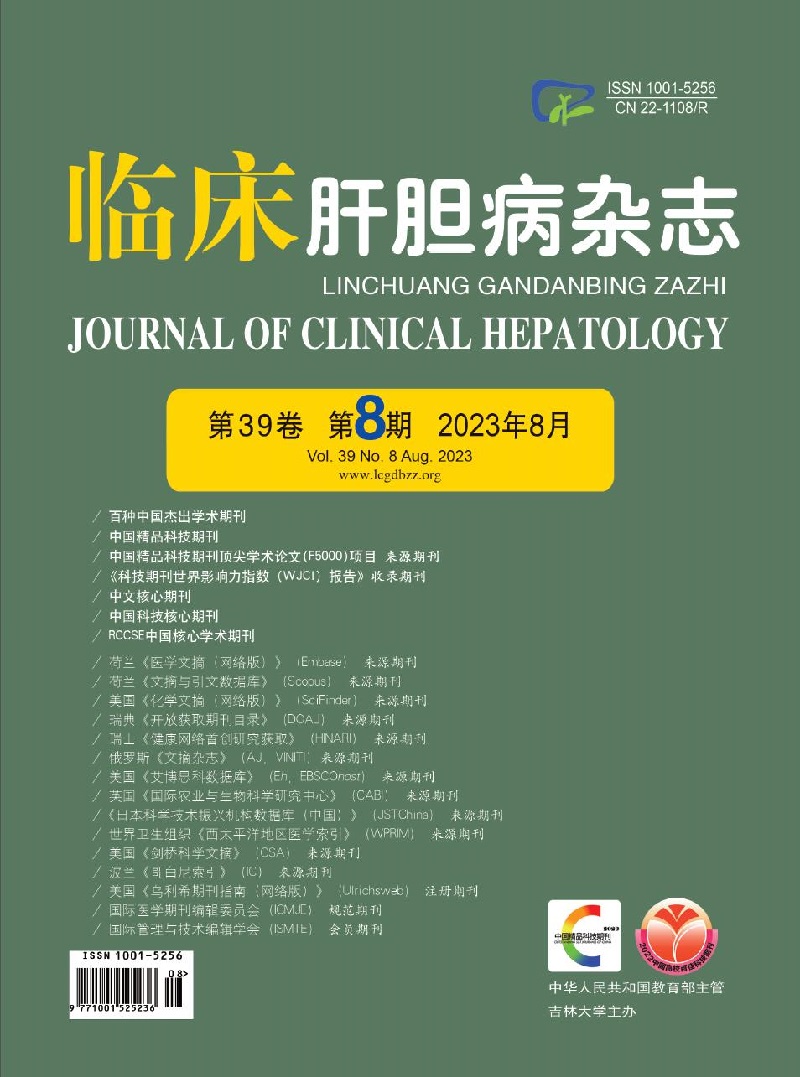| [1] |
XIAO J, WANG F, WONG NK, et al. Global liver disease burdens and research trends: Analysis from a Chinese perspective[J]. J Hepatol, 2019, 71(1): 212-221. DOI: 10.1016/j.jhep.2019.03.004. |
| [2] |
KIM D, TOUROS A, KIM WR. Nonalcoholic fatty liver disease and metabolic syndrome[J]. Clin Liver Dis, 2018, 22(1): 133-140. DOI: 10.1016/j.cld.2017.08.010. |
| [3] |
BUZZETTI E, PINZANI M, TSOCHATZIS EA. The multiple-hit pathogenesis of non-alcoholic fatty liver disease (NAFLD)[J]. Metabolism, 2016, 65(8): 1038-1048. DOI: 10.1016/j.metabol.2015.12.012. |
| [4] |
ECKBURG PB, BIK EM, BERNSTEIN CN, et al. Diversity of the human intestinal microbial flora[J]. Science, 2005, 308(5728): 1635-1638. DOI: 10.1126/science.1110591. |
| [5] |
WANG B, JIANG X, CAO M, et al. Altered fecal microbiota correlates with liver biochemistry in nonobese patients with non-alcoholic fatty liver disease[J]. Sci Rep, 2016, 6: 32002. DOI: 10.1038/srep32002. |
| [6] |
PARKS DJ, BLANCHARD SG, BLEDSOE RK, et al. Bile acids: natural ligands for an orphan nuclear receptor[J]. Science, 1999, 284(5418): 1365-1368. DOI: 10.1126/science.284.5418.1365. |
| [7] |
CHIANG J. Bile acid metabolism and signaling in liver disease and therapy[J]. Liver Res, 2017, 1(1): 3-9. DOI: 10.1016/j.livres.2017.05.001. |
| [8] |
CHÁVEZ-TALAVERA O, TAILLEUX A, LEFEBVRE P, et al. Bile acid control of metabolism and inflammation in obesity, type 2 diabetes, dyslipidemia, and nonalcoholic fatty liver disease[J]. Gastroenterology, 2017, 152(7): 1679-1694. e3. DOI: 10.1053/j.gastro.2017.01.055. |
| [9] |
ARAB JP, KARPEN SJ, DAWSON PA, et al. Bile acids and nonalcoholic fatty liver disease: Molecular insights and therapeutic perspectives[J]. Hepatology, 2017, 65(1): 350-362. DOI: 10.1002/hep.28709. |
| [10] |
CYPHERT HA, GE X, KOHAN AB, et al. Activation of the farnesoid X receptor induces hepatic expression and secretion of fibroblast growth factor 21[J]. J Biol Chem, 2012, 287(30): 25123-25138. DOI: 10.1074/jbc.M112.375907. |
| [11] |
MINARD AY, TAN SX, YANG P, et al. mTORC1 is a major regulatory node in the FGF21 signaling network in adipocytes[J]. Cell Rep, 2016, 17(1): 29-36. DOI: 10.1016/j.celrep.2016.08.086. |
| [12] |
DUTCHAK PA, KATAFUCHI T, BOOKOUT AL, et al. Fibroblast growth factor-21 regulates PPARγ activity and the antidiabetic actions of thiazolidinediones[J]. Cell, 2012, 148(3): 556-567. DOI: 10.1016/j.cell.2011.11.062. |
| [13] |
MOURIES J, BRESCIA P, SILVESTRI A, et al. Microbiota-driven gut vascular barrier disruption is a prerequisite for non-alcoholic steatohepatitis development[J]. J Hepatol, 2019, 71(6): 1216-1228. DOI: 10.1016/j.jhep.2019.08.005. |
| [14] |
LOU G, MA X, FU X, et al. GPBAR1/TGR5 mediates bile acid-induced cytokine expression in murine Kupffer cells[J]. PLoS One, 2014, 9(4): e93567. DOI: 10.1371/journal.pone.0093567. |
| [15] |
WAHLSTRÖM A, SAYIN SI, MARSCHALL HU, et al. Intestinal crosstalk between bile acids and microbiota and its impact on host metabolism[J]. Cell Metab, 2016, 24(1): 41-50. DOI: 10.1016/j.cmet.2016.05.005. |
| [16] |
HOUTEN SM, WATANABE M, AUWERX J. Endocrine functions of bile acids[J]. EMBO J, 2006, 25(7): 1419-1425. DOI: 10.1038/sj.emboj.7601049. |
| [17] |
den BESTEN G, van EUNEN K, GROEN AK, et al. The role of short-chain fatty acids in the interplay between diet, gut microbiota, and host energy metabolism[J]. J Lipid Res, 2013, 54(9): 2325-2340. DOI: 10.1194/jlr.R036012. |
| [18] |
CHAKRABORTI CK. New-found link between microbiota and obesity[J]. World J Gastrointest Pathophysiol, 2015, 6(4): 110-119. DOI: 10.4291/wjgp.v6.i4.110. |
| [19] |
MOUZAKI M, LOOMBA R. Insights into the evolving role of the gut microbiome in nonalcoholic fatty liver disease: rationale and prospects for therapeutic intervention[J]. Therap Adv Gastroenterol, 2019, 12: 1756284819858470. DOI: 10.1177/1756284819858470. |
| [20] |
SVEGLIATI-BARONI G, SACCOMANNO S, RYCHLICKI C, et al. Glucagon-like peptide-1 receptor activation stimulates hepatic lipid oxidation and restores hepatic signalling alteration induced by a high-fat diet in nonalcoholic steatohepatitis[J]. Liver Int, 2011, 31(9): 1285-1297. DOI: 10.1111/j.1478-3231.2011.02462.x. |
| [21] |
SMITH PM, HOWITT MR, PANIKOV N, et al. The microbial metabolites, short-chain fatty acids, regulate colonic Treg cell homeostasis[J]. Science, 2013, 341(6145): 569-573. DOI: 10.1126/science.1241165. |
| [22] |
ZHOU D, PAN Q, XIN FZ, et al. Sodium butyrate attenuates high-fat diet-induced steatohepatitis in mice by improving gut microbiota and gastrointestinal barrier[J]. World J Gastroenterol, 2017, 23(1): 60-75. DOI: 10.3748/wjg.v23.i1.60. |
| [23] |
SHARIFNIA T, ANTOUN J, VERRIERE TG, et al. Hepatic TLR4 signaling in obese NAFLD[J]. Am J Physiol Gastrointest Liver Physiol, 2015, 309(4): G270-G278. DOI: 10.1152/ajpgi.00304.2014. |
| [24] |
CECCARELLI S, PANERA N, MINA M, et al. LPS-induced TNF-α factor mediates pro-inflammatory and pro-fibrogenic pattern in non-alcoholic fatty liver disease[J]. Oncotarget, 2015, 6(39): 41434-41452. DOI: 10.18632/oncotarget.5163. |
| [25] |
NIGHOT M, AL-SADI R, GUO S, et al. Lipopolysaccharide-induced increase in intestinal epithelial tight permeability is mediated by toll-like receptor 4/Myeloid differentiation primary response 88 (MyD88) activation of myosin light chain kinase expression[J]. Am J Pathol, 2017, 187(12): 2698-2710. DOI: 10.1016/j.ajpath.2017.08.005. |
| [26] |
HARTE AL, da SILVA NF, CREELY SJ, et al. Elevated endotoxin levels in non-alcoholic fatty liver disease[J]. J Inflamm (Lond), 2010, 7: 15. DOI: 10.1186/1476-9255-7-15. |
| [27] |
ENGSTLER AJ, AUMILLER T, DEGEN C, et al. Insulin resistance alters hepatic ethanol metabolism: studies in mice and children with non-alcoholic fatty liver disease[J]. Gut, 2016, 65(9): 1564-1571. DOI: 10.1136/gutjnl-2014-308379. |
| [28] |
ZHU L, BAKER SS, GILL C, et al. Characterization of gut microbiomes in nonalcoholic steatohepatitis (NASH) patients: a connection between endogenous alcohol and NASH[J]. Hepatology, 2013, 57(2): 601-609. DOI: 10.1002/hep.26093. |
| [29] |
BAKER SS, BAKER RD, LIU W, et al. Role of alcohol metabolism in non-alcoholic steatohepatitis[J]. PLoS One, 2010, 5(3): e9570. DOI: 10.1371/journal.pone.0009570. |
| [30] |
CHEN X, ZHANG Z, LI H, et al. Endogenous ethanol produced by intestinal bacteria induces mitochondrial dysfunction in non-alcoholic fatty liver disease[J]. J Gastroenterol Hepatol, 2020, 35(11): 2009-2019. DOI: 10.1111/jgh.15027. |
| [31] |
MIR H, MEENA AS, CHAUDHRY KK, et al. Occludin deficiency promotes ethanol-induced disruption of colonic epithelial junctions, gut barrier dysfunction and liver damage in mice[J]. Biochim Biophys Acta, 2016, 1860(4): 765-774. DOI: 10.1016/j.bbagen.2015.12.013. |
| [32] |
HARTMANN P, SEEBAUER CT, MAZAGOVA M, et al. Deficiency of intestinal mucin-2 protects mice from diet-induced fatty liver disease and obesity[J]. Am J Physiol Gastrointest Liver Physiol, 2016, 310(5): G310-322. DOI: 10.1152/ajpgi.00094.2015. |
| [33] |
CORBIN KD, ZEISEL SH. Choline metabolism provides novel insights into nonalcoholic fatty liver disease and its progression[J]. Curr Opin Gastroenterol, 2012, 28(2): 159-165. DOI: 10.1097/MOG.0b013e32834e7b4b. |
| [34] |
YE JZ, LI YT, WU WR, et al. Dynamic alterations in the gut microbiota and metabolome during the development of methionine-choline-deficient diet-induced nonalcoholic steatohepatitis[J]. World J Gastroenterol, 2018, 24(23): 2468-2481. DOI: 10.3748/wjg.v24.i23.2468. |
| [35] |
BARREA L, ANNUNZIATA G, MUSCOGIURI G, et al. Trimethylamine- N-oxide (TMAO) as novel potential biomarker of early predictors of metabolic syndrome[J]. Nutrients, 2018, 10(12): 1971. DOI: 10.3390/nu10121971. |
| [36] |
ROMANO KA, MARTINEZ-DEL CAMPO A, KASAHARA K, et al. Metabolic, epigenetic, and transgenerational effects of gut bacterial choline consumption[J]. Cell Host Microbe, 2017, 22(3): 279-290. e7. DOI: 10.1016/j.chom.2017.07.021. |
| [37] |
GAO X, LIU X, XU J, et al. Dietary trimethylamine N-oxide exacerbates impaired glucose tolerance in mice fed a high fat diet[J]. J Biosci Bioeng, 2014, 118(4): 476-481. DOI: 10.1016/j.jbiosc.2014.03.001. |
| [38] |
JÄGER R, MOHR AE, CARPENTER KC, et al. International society of sports nutrition position stand: probiotics[J]. J Int Soc Sports Nutr, 2019, 16(1): 62. DOI: 10.1186/s12970-019-0329-0. |
| [39] |
ZHAO Z, WANG C, ZHANG L, et al. Lactobacillus plantarum NA136 improves the non-alcoholic fatty liver disease by modulating the AMPK/Nrf2 pathway[J]. Appl Microbiol Biotechnol, 2019, 103(14): 5843-5850. DOI: 10.1007/s00253-019-09703-4. |
| [40] |
BRISKEY D, HERITAGE M, JASKOWSKI LA, et al. Probiotics modify tight-junction proteins in an animal model of nonalcoholic fatty liver disease[J]. Therap Adv Gastroenterol, 2016, 9(4): 463-472. DOI: 10.1177/1756283X16645055. |
| [41] |
ALISI A, BEDOGNI G, BAVIERA G, et al. Randomised clinical trial: The beneficial effects of VSL#3 in obese children with non-alcoholic steatohepatitis[J]. Aliment Pharmacol Ther, 2014, 39(11): 1276-1285. DOI: 10.1111/apt.12758. |
| [42] |
SEPIDEH A, KARIM P, HOSSEIN A, et al. Effects of multistrain probiotic supplementation on glycemic and inflammatory indices in patients with nonalcoholic fatty liver disease: a double-blind randomized clinical trial[J]. J Am Coll Nutr, 2016, 35(6): 500-505. DOI: 10.1080/07315724.2015.1031355. |
| [43] |
ZVENIGORODSKAIA LA, CHERKASHOVA EA, SAMSONOVA NG, et al. Advisability of using probiotics in the treatment of atherogenic dyslipidemia[J]. Eksp Klin Gastroenterol, 2011, (2): 37-43.
|
| [44] |
SHAVAKHI A, MINAKARI M, FIROUZIAN H, et al. Effect of a probiotic and metformin on liver aminotransferases in non-alcoholic steatohepatitis: a double blind randomized clinical trial[J]. Int J Prev Med, 2013, 4(5): 531-537.
|
| [45] |
PACHIKIAN BD, ESSAGHIR A, DEMOULIN JB, et al. Prebiotic approach alleviates hepatic steatosis: implication of fatty acid oxidative and cholesterol synthesis pathways[J]. Mol Nutr Food Res, 2013, 57(2): 347-359. DOI: 10.1002/mnfr.201200364. |
| [46] |
CANI PD, POSSEMIERS S, van de WIELE T, et al. Changes in gut microbiota control inflammation in obese mice through a mechanism involving GLP-2-driven improvement of gut permeability[J]. Gut, 2009, 58(8): 1091-1103. DOI: 10.1136/gut.2008.165886. |
| [47] |
RASO GM, SIMEOLI R, IACONO A, et al. Effects of a Lactobacillus paracasei B21060 based synbiotic on steatosis, insulin signaling and toll-like receptor expression in rats fed a high-fat diet[J]. J Nutr Biochem, 2014, 25(1): 81-90. DOI: 10.1016/j.jnutbio.2013.09.006. |
| [48] |
MALAGUARNERA M, VACANTE M, ANTIC T, et al. Bifidobacterium longum with fructo-oligosaccharides in patients with non alcoholic steatohepatitis[J]. Dig Dis Sci, 2012, 57(2): 545-553. DOI: 10.1007/s10620-011-1887-4. |
| [49] |
LE ROY T, LLOPIS M, LEPAGE P, et al. Intestinal microbiota determines development of non-alcoholic fatty liver disease in mice[J]. Gut, 2013, 62(12): 1787-1794. DOI: 10.1136/gutjnl-2012-303816. |
| [50] |
XUE L, DENG Z, LUO W, et al. Effect of fecal microbiota transplantation on non-alcoholic fatty liver disease: a randomized clinical trial[J]. Front Cell Infect Microbiol, 2022, 12: 759306. DOI: 10.3389/fcimb.2022.759306. |














 DownLoad:
DownLoad: